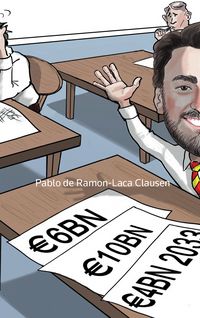A sharp deterioration in conditions posed a major challenge to borrowers in 2018. Nordea’s funding team had the additional hurdle of a strategic re-domiciliation to Finland, but the bank’s ability to navigate the pitfalls with foresight and flair makes it IFR’s Financial Issuer of the Year.
Nordea proposed moving its headquarters into the eurozone from Sweden in September 2017, seeing the relocation to Finland as placing it on a level playing field with European peers in a more predictable regulatory environment within the banking union.
It was the first large lender to relocate its headquarters outside of a merger. “It was a defining moment in our bank’s history,” said Ola Littorin, head of long-term funding at Nordea.
The re-domiciliation was completed on October 1 2018, the culmination of a remarkably smooth process in which the need to recalibrate Nordea’s liability stack in advance played a pivotal role. The bank also faced a higher funding target than in 2017, demanding regular trips to the wholesale market.
Despite the complexities, Nordea managed to issue around €24.5bn across 13 benchmarks, about 350 taps and private placements, across seven currencies and five products. Over that period it achieved historically tight pricing, reopened dormant markets and pioneered a new asset class for the Nordics.
That success was rooted in extensive investor dialogue to communicate clearly the implications of the Finnish move, which also helped Nordea retain its best-in-class investor relations profile.
While ratings agencies deemed the move credit-neutral – and the bank remained committed to protecting its Double A ratings – it was “very important to keep our investors really informed”, said Petra Mellor, chief treasury manager and head of bank debt at Nordea.
Members of the team conducted more than 500 meetings, an increase on the previous year’s 400, spanning 30 different countries globally.
SETTING THE BAR
The bank started IFR’s awards period on a high, proving just how low investors were willing to go on November 21 2017 with its no-grow €750m 3.5% perp non-call 2025, the smallest coupon to date achieved for any European Additional Tier 1 transaction in sterling, euros or US dollars.
Despite pricing some 125bp through the next lowest euro AT1 coupons, the deal pulled in more than €5bn of orders from over 380 investors and was trading up half a point by the end of that week. As Nordea’s first capital issuance following its decision to relocate, the results bore out investors’ strong continued appetite and confidence in the bank.
It came on the tail of an intricate consent solicitation targeting 14 tranches of outstanding capital instruments, effecting technical amendments to those bonds to reflect the move to Finland.
The bank was eager for the consent solicitation, which also updated subordination provisions to permit the issuance of senior non-preferred, to complete before its AGM in March. After some debate over the premium, it opted for 20 cents over 15 to strike the right balance with bondholders.
In the event it achieved a more than 90% acceptance rate, successfully eliminating documentation uncertainty for investors ahead of the move. The results also served as a springboard for the AT1 transaction, announced just one day later.
“It de-risked the AT1 because of the very strong support,” said Littorin: “It was a conscious sequencing of two trades.”
WINDOW SHOPPING
As in the case of Nordea’s peers, 2018’s torrid investment backdrop forced its funding team to be ever more nimble in its execution strategy. The fact that the Finnish move shortened its available issuance windows for internal reasons made that challenge even steeper.
“This year there were days when we stood down and others when we accelerated,” said Mellor. “Windows have opened quickly and shut quickly.”
Nordea was also shrewd in the way it interacted with its advisers, tending to mandate deals relatively late in the process. That enabled it to continue bilateral discussions with individual banks for longer, particularly important in a year when views on pricing and execution could vary wildly.
The bank’s inaugural US dollar-denominated senior non-preferred bond from August was a case in point. Though typically a quiet period for the market, Nordea spotted a window to front-run the heavy competing supply that was expected, and indeed emerged, following Labor Day.
Having checked investors were at their desks, it successfully priced a US$1bn five-year dual-tranche trade that was priced at a negative new issue concession when compared with Nordea’s outstanding senior curve.
The bank’s €1bn seven-year senior non-preferred issue in June was the first SNP in any currency from Sweden and featured contractual subordination to permit issuance ahead of the legal implementations in Sweden and Finland. It also issued the first benchmark SNP in Norwegian kroner.
NEW GROUND
Nordea also excelled in the covered bond market, returning after a 13-month absence to issue three tranches.
Its €750m 15-year in February was the tightest in this tenor to-date – part of a €2bn dual-tranche issue and IFR’s Covered Bond of the Year – while its €1bn seven-year in May reopened the covered bond sector after a period of volatility, setting the tone for the rest of the month.
In the preferred senior segment, its €1bn four-year FRN was priced at the tightest spread for any syndicated bond in this format since the financial crisis.
While Nordea diversified into multiple currencies, its local investor base remained an important source of funding that offered relative stability at times of stress in broader markets. It issued a combined €10bn-equivalent of domestic covered bond debt.
It also demonstrated considerable leadership and innovation across products and markets. For example, its NKr5bn five-year FRN covered bond was the first jointly syndicated benchmark covered in this currency, an approach that gave Nordea better control over price and size.
It also landed the Nordic region’s first ever callable 144A/Reg S Tier 2 bond in the Yankee market, a 15-year non-call 10 that took advantage of the growing acceptance of callable structures among US buyers. Pricing just two weeks after the bank’s inaugural US dollar SNP, at 175bp over Treasuries, it came as much as 10bp through where the bank would have priced a hypothetical shorter euro 10-year non-call five on the same day.
STRIKING THE BALANCE
Nordea’s inaugural Green bond, sold in June 2017, fell outside IFR’s award period. The bank did, however, publish its first Green Bond Impact Report in July 2018, showing its Green bond asset portfolio more than doubled its volume to €1.7bn.
Away from the public market it was active in private placements, placing €1.6bn of senior debt. It also successfully divested three non-performing loan portfolios to Nordic investors, triggering material capital gains for the group.
The bank came under scrutiny in October following allegations of money laundering by investor Bill Browder. It is also facing a US probe over potential breaches of sanctions. But at the time of writing Nordea had not received any fines or sanctions.
In its third-quarter report, the bank said: “The outcome of some investigations is pending and it cannot be excluded that these investigations could lead to criticism or sanctions.”
But those allegations should not detract from the funding team’s achievements, managing as it did the recalibration of its liability stack while also implementing a multi-billion issuance programme against a tempestuous backdrop.
Despite those challenges, the bank managed to lock in funding at competitive levels while balancing the objectives of investors and regulators. Its bold reopening of markets and inauguration of senior non-preferred bonds in the Nordics also instilled confidence in markets more broadly, as well as smoothing the way for other borrowers.
“We want to be a regular and very professional issuer,” said Mellor. “We want to be a leader in the market, pave the way for the market and leave the market in a better place.”
To see the digital version of IFR Awards 2018, please click here.
To purchase printed copies or a PDF of IFR Awards 2018, please email gloria.balbastro@refinitiv.com.



